Effect of Skeletal Muscle Mass and Occlusal State on Flight Time of Straight Jumps in Trampoline Competition
Mutsumi Takahashi1*, Yogetsu Bando2, Takuya Fukui3,4
1Department of Physiology, The Nippon Dental University School of Life Dentistry at Niigata, Japan
2Bando Dental Clinic, Ishikawa, Japan
3Department of Sport Science, Kanazawa Gakuin University of Sport Science, Ishikawa, Japan
4Japan Gymnastics Association Trampoline Committee, Tokyo, Japan
*Corresponding Author: Mutsumi Takahashi, Department of Physiology, The Nippon Dental University School of Life Dentistry at Niigata, Japan
Received: 16 August 2023; Accepted 24 August 2023; Published: 30 August 2023
Article Information
Citation: Mutsumi Takahashi, Yogetsu Bando, Takuya Fukui. Effect of Skeletal Muscle Mass and Occlusal State on Flight Time of Straight Jumps in Trampoline Competition. Dental Research and Oral Health. 6 (2023): 52-57.
View / Download Pdf Share at FacebookAbstract
The aim of this study was to clarify the effects of skeletal muscle mass and occlusal state on flight time of straight jumps in the trampoline competition. Participants were 11 elite-level trampoline male athletes (18.9 ± 0.9 years). A body composition analyzer was used to measure skeletal muscle mass, the left–right difference in the muscle mass of the lower extremities and ratio of trunk muscle mass to whole-body muscle mass were calculated. A pressure-sensitive film was used to measure the occlusal state, and the left-right difference in occlusal force was obtained. The trial consisted of 10 consecutive straight jumps, and the flight time was measured. Pearson’s product-moment correlation coefficient was used to analyze the correlations between flight time and the left–right difference in lower-extremity muscle mass, the ratio of trunk muscle mass to whole-body muscle mass, and the left–right difference in occlusal force. Significant negative correlation was observed between the flight time and the left-right difference in lower extremity muscle mass or occlusal force. Significant and strong positive correlation was observed between flight time and the ratio of trunk muscle mass to whole-body muscle mass. The results of this study suggest that the flight time of straight jumps in the trampoline competition is influenced by the balance of skeletal muscle mass and occlusal state. Therefore, the stability of the trunk supported by well-balanced posture muscles on the left and right sides as well as appropriate occlusal contact should contribute to improvements in flight time.
Keywords
Skeletal muscle mass, Occlusal state, Flight time, Straight jump, Trampoline competition
Skeletal muscle mass articles; Occlusal state articles; Flight time articles; Straight jump articles; Trampoline competition articles
Skeletal muscle mass articles Skeletal muscle mass Research articles Skeletal muscle mass review articles Skeletal muscle mass PubMed articles Skeletal muscle mass PubMed Central articles Skeletal muscle mass 2023 articles Skeletal muscle mass 2024 articles Skeletal muscle mass Scopus articles Skeletal muscle mass impact factor journals Skeletal muscle mass Scopus journals Skeletal muscle mass PubMed journals Skeletal muscle mass medical journals Skeletal muscle mass free journals Skeletal muscle mass best journals Skeletal muscle mass top journals Skeletal muscle mass free medical journals Skeletal muscle mass famous journals Skeletal muscle mass Google Scholar indexed journals Occlusal state articles Occlusal state Research articles Occlusal state review articles Occlusal state PubMed articles Occlusal state PubMed Central articles Occlusal state 2023 articles Occlusal state 2024 articles Occlusal state Scopus articles Occlusal state impact factor journals Occlusal state Scopus journals Occlusal state PubMed journals Occlusal state medical journals Occlusal state free journals Occlusal state best journals Occlusal state top journals Occlusal state free medical journals Occlusal state famous journals Occlusal state Google Scholar indexed journals Flight time articles Flight time Research articles Flight time review articles Flight time PubMed articles Flight time PubMed Central articles Flight time 2023 articles Flight time 2024 articles Flight time Scopus articles Flight time impact factor journals Flight time Scopus journals Flight time PubMed journals Flight time medical journals Flight time free journals Flight time best journals Flight time top journals Flight time free medical journals Flight time famous journals Flight time Google Scholar indexed journals Straight jump articles Straight jump Research articles Straight jump review articles Straight jump PubMed articles Straight jump PubMed Central articles Straight jump 2023 articles Straight jump 2024 articles Straight jump Scopus articles Straight jump impact factor journals Straight jump Scopus journals Straight jump PubMed journals Straight jump medical journals Straight jump free journals Straight jump best journals Straight jump top journals Straight jump free medical journals Straight jump famous journals Straight jump Google Scholar indexed journals Trampoline competition articles Trampoline competition Research articles Trampoline competition review articles Trampoline competition PubMed articles Trampoline competition PubMed Central articles Trampoline competition 2023 articles Trampoline competition 2024 articles Trampoline competition Scopus articles Trampoline competition impact factor journals Trampoline competition Scopus journals Trampoline competition PubMed journals Trampoline competition medical journals Trampoline competition free journals Trampoline competition best journals Trampoline competition top journals Trampoline competition free medical journals Trampoline competition famous journals Trampoline competition Google Scholar indexed journals posture muscles articles posture muscles Research articles posture muscles review articles posture muscles PubMed articles posture muscles PubMed Central articles posture muscles 2023 articles posture muscles 2024 articles posture muscles Scopus articles posture muscles impact factor journals posture muscles Scopus journals posture muscles PubMed journals posture muscles medical journals posture muscles free journals posture muscles best journals posture muscles top journals posture muscles free medical journals posture muscles famous journals posture muscles Google Scholar indexed journals stomatognathic system articles stomatognathic system Research articles stomatognathic system review articles stomatognathic system PubMed articles stomatognathic system PubMed Central articles stomatognathic system 2023 articles stomatognathic system 2024 articles stomatognathic system Scopus articles stomatognathic system impact factor journals stomatognathic system Scopus journals stomatognathic system PubMed journals stomatognathic system medical journals stomatognathic system free journals stomatognathic system best journals stomatognathic system top journals stomatognathic system free medical journals stomatognathic system famous journals stomatognathic system Google Scholar indexed journals
Article Details
Introduction
The trampoline competition is an event consisting of 10 jumps in which different techniques are performed for a total of nearly 20s in the air, with scoring based on the following four items: 1) performance of technique, 2) number of rotations and twists, 3) flight time, and 4) displacement of landing position [1-4]. Performance ability is determined by the control and stability of balance during jumping, including aerial and landing posture. The straight jump is the most basic exercise in trampoline competitions, and it involves using the strong repulsive force of the bed transmitted from the soles of the feet to maintain an upright position in the air [1,4]. Maintaining a posture in which the shoulders, hip joints, knees, and lateral malleolus are in a straight line is the basis of aerial posture.
Previous studies have evaluated the stability of standing posture by examining the center-of-gravity sway [3,5-10]. The relationship between center-of-gravity sway and occlusion has been investigated by research on the relationship between occlusal contact state and displacement of the center of foot pressure, and it was found that athletes with good occlusal contact state tend to have a small outer peripheral area and a large trajectory length per unit area [3] and that improving occlusal contact state by wearing a mouthguard reduces deviation of the center of foot pressure [11]. Furthermore, in terms of the relationship between center-of-gravity sway and muscle, it has been reported that lower-extremity muscle strength and total trajectory length are related [12,13], lower-extremity muscle strength and dynamic balance are related [14], and trunk muscle mass and dynamic balance are related [14].
Previous research investigating the relationship between physical function and occlusion in athletes has clarified the following: 1) center-of-gravity sway measured in the intercuspal position is superior in gymnasts compared with weightlifters and healthy adults [11]; 2) the occlusal balance of badminton players influences their agility [15,16]; 3) the effect of improving occlusal contact state by wearing a mouthguard on center-of-gravity sway is more pronounced in balance athletes than in muscle strength athletes [11]; 4) improving the occlusal contact state by wearing a mouthguard brings about improvements in handball players’ physical performance, particularly in terms of agility, instantaneous power, muscle strength, and jumping ability [17]; and 5) the effect of improving occlusal contact by wearing a mouthguard on physical function is useful for athletes with poor occlusal contact state [17]. Taken together, these findings suggest that the occlusal state and the composition of skeletal muscles affect the motor functions involved in postural control. Therefore, this study focused on straight jumps performed in the trampoline competition for which standing postural control is the basis of the movement.
The aim of this study was to clarify the effects of skeletal muscle mass and occlusal state on the flight time of straight jumps. The null hypothesis was that flight time is not affected by skeletal muscle mass and occlusion.
Materials and Methods
Participants
Participants were 11 male trampoline gymnasts (age, 18.9 ± 0.9 years) with 12–16 years of competition experience (13.7 ± 1.7 years). There was no tooth loss except for the third molar and no subjective or objective abnormalities in the stomatognathic system. This study was approved by the Ethics Committee of The Nippon Dental University School of Life Dentistry at Niigata (ECNG-R-375). The details of the study were described in full to all participants, and written informed consent was obtained from all participants prior to their participation.
Measurement of skeletal muscle mass
A dual-frequency body composition analyzer (Inner Scan Dual RD-800; Tanita Corp., Tokyo, Japan) was used to measure skeletal muscle mass. Measurements were performed using an 8-point contact electrode method in which current was supplied from the electrodes at the distal ends of the extremities. Participants were instructed to hold the grip with both hands while standing on the body composition monitor with their bare feet, with both elbow joints extended and the shoulder joint flexed to approximately 90° (Figure 1). The measurement items were total body muscle mass, trunk muscle mass, upper extremity muscle mass (left and right), and lower-extremity muscle mass (left and right). From these measurements, the left–right difference in the muscle mass of the lower extremities (%) and ratio of trunk muscle mass to whole-body muscle mass (%) were calculated.
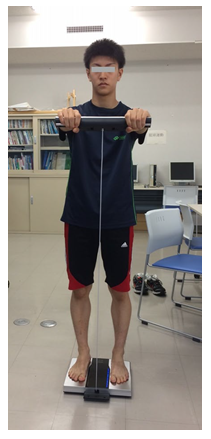
Figure 1: Measurement of skeletal muscle mass, using a body composition analyzer (Inner Scan DUAL RD-800)
Measurement of the occlusal state
A pressure-sensitive film (Dental Prescale, 50H-R type; Fujifilm Co., Ltd., Tokyo) and the manufacturer’s dedicated analysis device (Occluzer FPD-709; Fujifilm Co., Ltd.) were used to examine the occlusal state [3,7,11,15-17]. Participants were instructed to position the occlusal plane parallel to the floor, insert the pressure-sensitive film into the oral cavity, and perform maximum clenching for 3 s in the intercuspal position. Then, the pressure-sensitive film was removed, and the left–right difference in occlusal force (%) was analyzed by the analysis device (Figure 2).
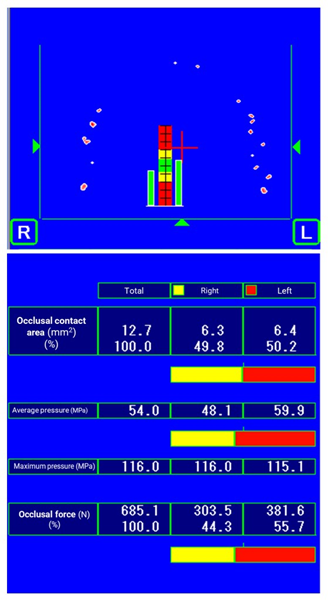
Figure 2: Analysis results of occlusal contact state, using Occluzer (FPD-709)
Measurement of flight time in straight jump
An all-in-one measurement system (HDTS EU-7100; Eurotramp, Weilheim an der Teck, Germany) was used to measure the flight time. Calibration was performed and then recording was started. The trial consisted of 10 consecutive straight jumps. Three preliminary jumps were performed, and recording was started from the subsequent jumps. The time away from the bed during the 10 jumps was recorded (Figure 3). Trials were performed three times, and the average value was used for analysis.
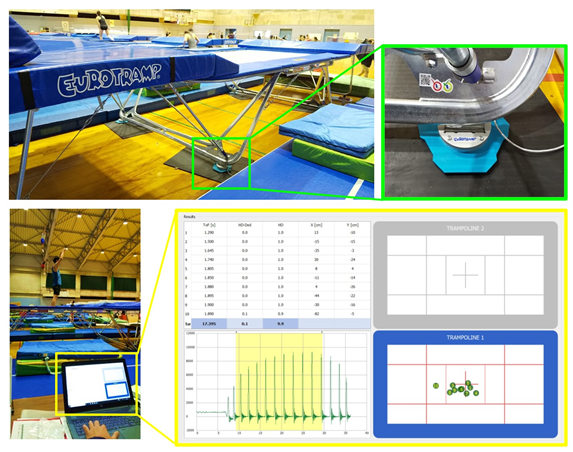
Figure 3: Measurement of flight time, using an all-in-one measurement system (HDTS EU-7100)
Statistical analysis
Statistical analysis was performed using IBM SPSS 24.0 (SPSS Japan Inc., Tokyo). For all measured values, the Shapiro–Wilk test was used for the normality test. Normality was observed in the variables for the left–right difference in lower-extremity muscle mass, the ratio of trunk muscle mass to whole-body muscle mass, left–right difference in occlusal force, and flight time. Therefore, Pearson’s product-moment correlation coefficient was used to analyze the correlations between flight time and the left–right difference in lower-extremity muscle mass, the ratio of trunk muscle mass to whole-body muscle mass, and the left–right difference in occlusal force. Significance was set at p < 0.05.
Results
A significant and strong negative correlation was observed between flight time and the left–right difference in lower-extremity muscle mass (p < 0.05, R = −0.703). Participants with a smaller left–right difference in lower-extremity muscle mass tended to have longer flight times (Figure 4).
A significant and strong positive correlation was observed between flight time and the ratio of trunk muscle mass to whole-body muscle mass (p < 0.01, R = 0.778). Participants with a higher ratio of trunk muscle mass to whole-body muscle mass tended to have longer flight times (Figure 5).
A significant negative correlation was observed between flight time and the left–right difference in occlusal force (p < 0.05, R = −0.663). Participants with a smaller left–right difference in occlusal force tended to have longer flight times (Figure 6).
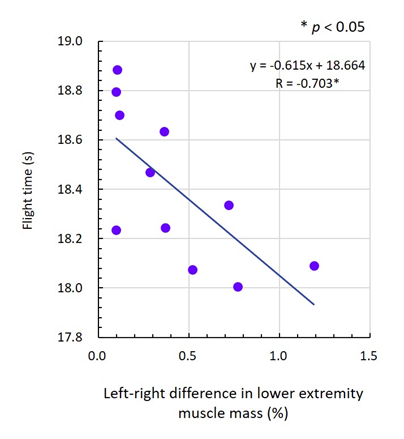
Figure 4: Correlation between left–right difference in lower-extremity muscle mass and flight time in the straight jump
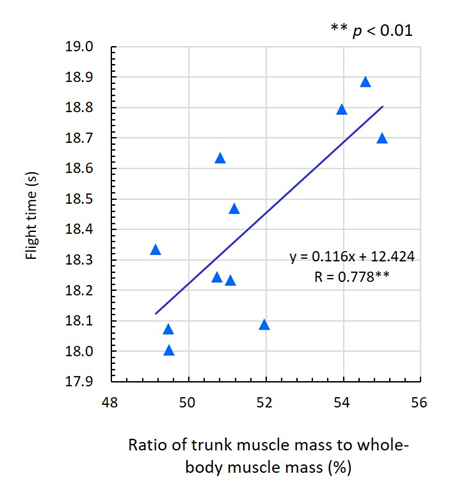
Figure 5: Correlation between the ratio of trunk muscle mass to whole-body muscle mass and flight time in the straight jump
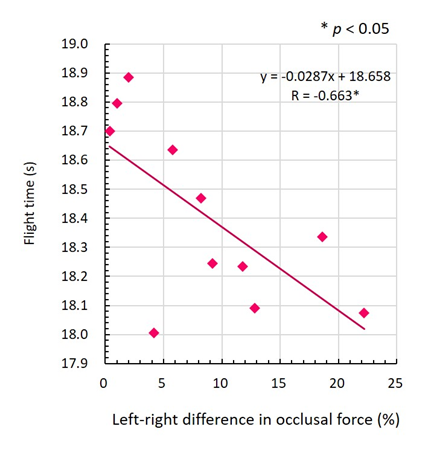
Figure 6: Correlation between left–right difference in occlusal force and flight time in the straight jump
Discussion
The results of this study showed that the flight time of straight jumps tended to be longer for participants with a smaller left–right difference in lower-extremity muscle mass or smaller occlusal force and with a greater ratio of trunk muscle mass to whole-body muscle mass. Therefore, the null hypothesis was rejected.
In the trampoline competition, jumping involves using the repulsive force of the bed to move vertically [4]. To make the most of the elastic energy of the bed in continuous straight jumps, it is necessary to repeat the motion of jumping straight up from the center of the bed, falling along a vertical line, and landing again in the center of the bed. Specifically, 1) the joints of each part of the body should be fixed and the landing position should be approached with both lower limbs extended, 2) both arms and both shoulders should be dropped farther at the time of landing, and 3) landing should be performed on the center of the bed with both soles at the same time [18,19]. If all three of these actions are achieved, the flight time will be extended. The four scoring items in the trampoline competition are the evaluation of technique (E-score), difficulty in terms of number of rotations and twists (D-score), the time of flight (T-score), and the evaluation of the horizontal landing position from the center of the bed (H-score). Extending the flight time (i.e., higher T-score) positively impacts the D-score and E-score. The H-score is also affected because landing in the center of the bed is a prerequisite for extending the flight time. In this way, the items used to score the trampoline competition can be considered to influence each other. In particular, the H-score and T-score reflect the ability to perform a stable continuous jump, given that rotation and twisting cannot be performed unless the landing position and flight time are guaranteed. In this study, the straight jump was selected as a trial that did not involve rotation or twisting in order to minimize the influence of factors other than body structure on the measured values. In addition, the all-in-one measurement system used to measure the flight time accurately evaluated the time the body was away from the bed by using external pressure sensors installed on the four legs of the trampoline equipment. Using this approach, it is possible to perform objective evaluations that do not include variations in evaluations among examiners.
The results of this study revealed a significant and strong negative correlation between flight time and the left–right difference in lower-extremity muscle mass as well as a significant and strong positive correlation between flight time and the ratio of trunk muscle mass to whole-body muscle mass. From these results, it was clarified that flight time is affected by the left–right balance of skeletal muscles and the posture-maintenance muscles that make up the trunk. There are four main methods for measuring skeletal muscle mass. Computed tomography (CT), magnetic resonance imaging (MRI), and dual energy X-ray absorptiometry are three such methods and have advantages in terms of being able to measure body composition in great detail. However, they also have disadvantages in that the measuring equipment is expensive and the analysis is time-consuming to perform. Furthermore, CT and dual-energy X-ray absorptiometry involve radiation exposure. In contrast, bioelectrical impedance analysis can evaluate body composition by measuring the electrical resistance of living tissue by using a weak electrical current that is harmless to the body. This method is inexpensive, non-invasive, and is correlated with the measured values of dual-energy X-ray absorptiometry, which is the basis of body composition measurement, and has been recognized for its reliability and validity [20]. Therefore, in this study, the bioelectrical impedance method was performed using a body composition meter. There are two reasons that the left–right difference in lower-extremity muscle mass and the ratio of trunk muscle mass to whole-body muscle mass were used in this study. The first is that the landing posture is a state in which both lower limbs are extended. The second is that the jumping posture is stabilized by maintaining the standing posture (by mainly the erector spinae, abdominal muscles, and quadriceps) and by controlling the leg joints (by the triceps surae) [18,19]. Then, at the moment of taking off again after landing, the left and right soles simultaneously push the center of gravity into the center of the bed and utilize the elastic energy of the bed in a vertical direction that matches the long axis of the body [18,19]. Therefore, it was inferred that equality of left and right leg strength as well as utilization of posture-maintenance muscles supported by the trunk muscles are desirable for jumping. The results of this study showed that athletes with a large ratio of trunk muscle mass to whole-body muscle mass and a small left–right difference in lower-extremity muscle mass tended to have a longer flight time. This suggested that the plumb movement against the movement of the center of gravity during jumping was supported by posture-maintenance muscles. Based on this trend, it was speculated that the left–right balance of lower-extremity muscle mass might have an effect on the landing posture and takeoff motion. In the future, it will be necessary to verify the relationship between skeletal muscle mass and landing position.
Next, the relationship between flight time and the left–right difference in occlusal force was examined. There was a tendency for the flight time to be significantly longer in participants with a smaller left–right difference in occlusal force. This may have been influenced by the fact that all participants in this study were clenching just prior to landing. Similar to lower-extremity muscle mass, it is possible that the occlusal state affected postural stability during landing. The trial in this study was a straight jump, but in the case of jumps involving rotation and twisting, the landing position and landing posture are often disturbed. By wearing a mouthguard fabricated using elastic material and improving the contact condition of the occlusion, it is possible to stabilize the clench in preparation for landing, even if the body axis is misaligned. This can be expected to have a positive effect on trampoline performance. If occlusal intervention can support stable jumping circulation, it may lead to the prevention of sports injuries considering that disturbances in the landing posture and/or landing position can lead to serious accidents such as falling outside the trampoline frame.
There are two main limitations of this research. First, the number of participants is small. In the future, it will be necessary to increase the number of participants and determine the difference in occlusal balance and determine the effect of correcting the occlusal balance by wearing a mouthguard. Second, no muscle activity was recorded during the straight jumps. It is therefore necessary to investigate the timing and duration of clenching and muscle activity during jumping by recording postural muscle activity. Future findings can be expected to contribute to the reduction of sports injuries and the improvement of competitiveness.
Conclusion
The results of this study suggest that the flight time of straight jumps in the trampoline competition is influenced by the balance of skeletal muscle mass and occlusal state. Therefore, the stability of the trunk supported by well-balanced posture muscles on the left and right sides as well as appropriate occlusal contact should contribute to improvements in flight time.
Data availability
The datasets collected and/or analyzed during the current study are available from the corresponding author on reasonable request.
Acknowledgments
This work was supported by JSPS KAKENHI Grant Number JP23K10617.
Conflicts of interest statement
The authors have no conflicts of interest relevant to this article.
References
- Izumi T. Report on trampoline competitions that involved in as a physical coach: Physical training strengthening plan for the national team. NSCA JAPAN 25 (2018): 26-30.
- Matsushima M, Yano S. Relation between muscle activity during takeoff and landing positions in the trampoline straight jump. Res J Sports Perf 10 (2018): 15-26.
- Bando Y, Takahashi M, Fukui T, et al. Relationship between occlusal state and posture control function of trampoline gymnasts. J Sports Dent 23 (2019): 14-20.
- Ito N, Yamazaki H, Hirai T, et al. Kinematics on straight jump in trampoline. Bull of Nippon Sport Sci Univ 30 (2000): 59-64.
- Uchiyama Y. Posture control. JPTS 10 (1995): 221-231.
- Asseman FB, Caron O, Crémieux J. Are there specific conditions for which expertise in gymnastics could have an effect on postural control and performance? Gait Posture 27 (2008): 76-81.
- Bando Y. Relationship between accuracy of badminton overhead shots and occlusal contact J Sports Dent 13 (2009): 29-36.
- Marini I, Gatto MR, Bartolucci ML, et al. Effects of experimental occlusal interference on body posture: an optoelectronic stereophotogrammetric analysis. J Oral Rehabil 40 (2013): 509-518.
- Itaya A. Feedback system for sensory and postural control. J Biomech 39 (2015): 197-203.
- Bando Y, Takahashi M, Oguchi T, et al. Dental support for Olympic skeleton designated player. J Sports Dent 22 (2019): 50-55.
- Takahashi M, Bando Y, Fukui T, et al. Equalization of the occlusal state by wearing a mouthguard contributes to improving postural control function. Appl Sci 13 (2023): 4342.
- Hirase T, Inokuchi S, Shiozuka J, et al. Relationshi between balance ability and lower extremity muscular strength in the elderly: comparison by gender, age, and Tokyo metropolitan institute of gerontology (TMIG) index of competence. Rigakuryoho Kagaku 23 (2008): 641-646.
- Takei K, Murata S, Kai Y. The relationship between toe function and static/dynamic balance: evaluation of content validity. West Kyushu J Rehabil Sci 2 (2009): 13-19.
- Matsuno S, Kouda T, Fujita N. Relationships between regional muscle mass measured using a household body composition meter and center of pressure sway and the functional reach test in healthy adult men. Rigakuryoho Kagaku 35 (2020): 165-169.
- Takahashi M, Bando Y. Relationship between occlusal balance and agility in Japanese elite female junior badminton players. Int J Sports Dent 11 (2018): 34-42.
- Bando Y, Takahashi M, Kitayama Y. Relationship between oral function and motor ability of top Japanese junior badminton players: part 1 examination of occlusal force by Dental Prescale. J Sports Dent 21 (2018): 23-30.
- Takahashi M, Bando Y, Kitaoka K, et al. Influence of occlusal state on posture control and physical fitness of elite athletes: Examination targeting female handball players. J Sports Dent 24 (2020): 18-25.
- Ito Y. Basic training trampoline text book 2006. Bull of Ryutsu Keizai Univ 1 (2008): 149-171.
- Ito Y. Basic training trampoline text book 2008. Bull of Ryutsu Keizai Univ 1 (2009): 139-179.
- Kyle UG, Genton L, Hans D, et al. Validation of a bioelectrical impedance analysis equation to predict appendicular skeletal muscle mass (ASMM). Clin Nutr 22 (2003): 537-543.


 Impact Factor: * 3.1
Impact Factor: * 3.1 Acceptance Rate: 76.66%
Acceptance Rate: 76.66%  Time to first decision: 10.4 days
Time to first decision: 10.4 days  Time from article received to acceptance: 2-3 weeks
Time from article received to acceptance: 2-3 weeks 